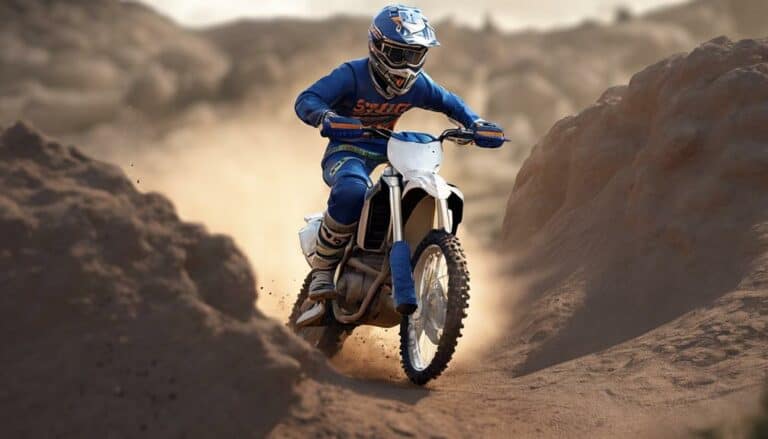When tackling obstacles and rough terrain on a dirt bike, your body becomes a compass, guiding you through the twists and turns of the rugged landscape. Each shift in weight, every subtle adjustment of your position, can mean the difference between a smooth ride and a bumpy journey.
But how exactly does body positioning impact your ability to conquer these challenges? Let's explore the intricate dance between rider and machine, where precision and technique are paramount to mastering the art of conquering difficult terrain on a dirt bike.
Key Takeaways
- Proper body positioning enhances stability and control on rough terrain.
- Distribute weight evenly, lean towards obstacles, and use legs and arms for shock absorption.
- Adapt body position to terrain changes, grip bike with knees, and maintain a neutral position.
- Mastering rough terrain requires using legs as shock absorbers, relaxing grip, and practicing on varied terrains.
Importance of Proper Body Positioning
Proper body positioning on a dirt bike greatly enhances stability, control, and maneuverability, important for getting through obstacles and rough terrain effectively. By centering your body over the bike's pivot point, you secure even weight distribution, providing a solid foundation for conquering challenging terrain. Gripping the bike with your knees and leaning forward optimizes traction and balance, important for confidently overcoming obstacles. When you lean in the direction of turns, you shift the center of gravity, enhancing handling and control while traversing rough terrain.
This ideal body positioning not only reduces the risk of accidents but also improves shock absorption, enabling smoother traversal over obstacles on a dirt bike. Embracing the correct posture and technique will empower you to tackle various terrains with precision and confidence. Remember, your body isn't just a passenger on the bike; it's a crucial component that can significantly impact your overall riding experience.
Enhancing Stability and Control
Enhance stability and control on your dirt bike by mastering precise body positioning techniques that optimize weight distribution and traction.
- Equal Weight Distribution: Distribute your weight evenly on the bike to prevent tipping over on rough terrain, enhancing stability.
- Grip and Lean: Maintain control by gripping the bike with your knees and leaning forward, ensuring balance while managing obstacles like rocks and roots.
- Elbow Flexibility: Keep your elbows bent and relaxed for better shock absorption, reducing the impact of rough terrain and improving control.
- Lean Into Turns: Lean your body in the direction of obstacles or turns to optimize traction and control, enhancing maneuverability through challenging terrain.
Navigating Obstacles With Precision
Mastering precise body positioning techniques is essential for efficiently maneuvering obstacles with precision on a dirt bike. When maneuvering obstacles, proper weight distribution and control are critical for stability and balance. Gripping the bike with your knees and leaning forward help distribute weight effectively, enhancing control over the bike on rough terrain. Leaning your upper body towards the obstacle aids in maneuvering the bike efficiently, reducing the likelihood of accidents. Using your legs and arms as shock absorbers during obstacles absorbs impact, ensuring a smoother ride and better control. Adapting your body position to suit the type of obstacle or terrain you're facing optimizes traction, balance, and control, enabling you to maneuver challenging paths with confidence.
| Key Points | Benefits |
|---|---|
| Proper weight distribution | Enhanced control |
| Leaning towards the obstacle | Improved maneuvering |
| Using legs and arms as shock absorbers | Smoother ride |
| Adapting body position to terrain | Optimal traction |
| Gripping bike with knees | Better stability |
Techniques for Rough Terrain Mastery
When traversing rough terrain on a dirt bike, maintaining a neutral body position with bent knees and raised elbows is essential for absorbing shocks and ensuring stability. Here are four techniques that can help you master rough terrain:
- Use Your Legs as Shock Absorbers: By bending your knees and using your legs to absorb the impacts from bumps and obstacles, you can maintain stability and control over your bike.
- Relax Your Grip: Keeping a relaxed grip on the handlebars allows for better maneuverability and smoother navigation through rough terrain, helping you tackle obstacles with ease.
- Distribute Weight Evenly: Leaning your body slightly back while standing on the footpegs helps distribute your weight evenly on the bike, preventing loss of traction on uneven surfaces.
- Practice on Varied Terrains: Regular practice on different terrains enhances your ability to adapt your body positioning to various obstacles and terrain types, improving your balance, stability, and overall riding experience.
Mastering these body positioning techniques won't only help you navigate rough terrain safely but also enhance your riding experience by providing better control and confidence.
Maximizing Performance Through Body Positioning
To optimize your dirt bike's performance, precise body positioning is essential for maximizing traction and control while negotiating obstacles and rough terrain. Proper weight distribution through strategic body positioning enhances traction, allowing you to grip the terrain with confidence.
Leaning forward in the attack position not only boosts stability but also increases maneuverability, enabling you to navigate obstacles with precision. By gripping the bike with your knees and keeping your elbows up, you can minimize the impact of rough terrain, ensuring a smoother ride.
Adapting your body position to terrain changes is vital for maintaining control and balance, especially when faced with varying obstacles. Mastering these body positioning techniques can result in a significant 20% improvement in maneuverability, empowering you to conquer challenging terrain and obstacles more effectively.
Conclusion
To sum up, mastering proper body positioning on a dirt bike is like fine-tuning a precision instrument. By aligning your body correctly, distributing weight effectively, and adjusting to the terrain, you can navigate obstacles with ease and enhance your overall performance.
Remember, just as a skilled musician adjusts their grip on an instrument for best sound, a dirt bike rider must adjust their body position for best control and stability.
Keep refining your technique to maximize your riding experience.

